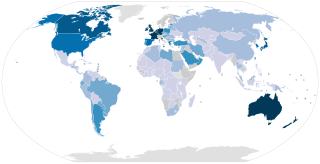 W
WThis is a list of the official minimum wage rates of the 193 United Nations member states and former members of the United Nations, also including the following territories and states with limited recognition: Northern Cyprus, and Kosovo and other independent countries. Some countries may have a very complicated minimum wage system; for example, India has more than 1202 minimum wage rates.
 W
WAs different parts of China have very different standards of living, China does not set one minimum wage for the entire nation. Instead, the task of setting minimum wages is delegated to the local governments. Each province, municipality, or region sets its own minimum wage in accordance with its own local conditions. According to the country's Employment Promotion Plan, minimum wages are supposed to increase in accordance with local living standards by at least 13 percent through 2015 and be no less than 40 percent of the average local wages. Minimum wages under such policies increased by an average 12.6 percent rate between 2008-2012. However, the growth rate of minimum wage levels decreased in 2016, reflecting the Chinese government’s effort to reduce pressure on enterprises resulting from the uneven growth between labor costs and production rates.
 W
WThe following list provides information relating to the (gross) minimum wages of in the European Union member states.
 W
WGermany's minimum wage legislation was introduced on January 1, 2015, by Angela Merkel's third government, a coalition between the SPD and the CDU. The implementation of a minimum wage was the SPD's main request during the coalition's negotiations as its central electoral promise during the 2013 federal election campaign. Previously, Germany had minimum wages only in specific sectors, negotiated by trade unions, and some were below the minimum wage level introduced in 2015.
 W
WA living wage is defined as the minimum income necessary for a worker to meet their basic needs. This is not the same as a subsistence wage, which refers to a biological minimum. Needs are defined to include food, housing, and other essential needs such as clothing. The goal of a living wage is to allow a worker to afford a basic but decent standard of living through employment without government subsidies. Due to the flexible nature of the term "needs", there is not one universally accepted measure of what a living wage is and as such it varies by location and household type. A related concept is that of a family wage – one sufficient to not only support oneself, but also to raise a family.
 W
WThe Minimum Wage Fairness Act is a bill that would amend the Fair Labor Standards Act of 1938 (FLSA) to increase the federal minimum wage for employees to $10.10 per hour over the course of a two-year period. The bill was strongly supported by President Barack Obama and many of the Democratic Senators, but strongly opposed by Republicans in the Senate and House.
 W
WThe National Federation of Women Workers (NFWW) was a trade union in the United Kingdom of Great Britain and Ireland active in the first part of the 20th century. Instrumental in winning women workers the right to a minimum wage for the first time, the NFWW broke down barriers for women's membership in trade unions in general.
 W
WThe South Korean government enacted the Minimum Wage Act on December 31, 1986. The Minimum Wage System began on January 1, 1988. At this time the economy was booming, and the minimum wage set by the government was less than 30 percent of that of real workers. The Minister of Employment and Labor in Korea asks the Minimum Wage Commission to review the minimum wage by March 31 every year. The Minimum Wage Commission must submit the minimum wage bill within 90 days after the request has been received by the 27 committee members. If there is no objection, the new minimum wage will then take effect from January 1. The minimum wage committee decided to raise the minimum wage in 2018 by 16.4% from the previous year to 7,530 won (US$7.03) per hour. This is the largest increase since 2001 when it was increased by 16.8%.
 W
WThe minimum wage in the United States is set by U.S. labor law and a range of state and local laws. The first federal minimum wage was created as part of the National Industrial Recovery Act of 1933, signed into law by President Franklin D. Roosevelt, but declared unconstitutional. In 1938 the Fair Labor Standards Act established it at $0.25 an hour. Its purchasing power peaked in 1968 at $1.60. Since 2009, it has been $7.25 per hour.
 W
WThe working poor are working people whose incomes fall below a given poverty line due to low-income jobs and low familial household income. These are people who spend at least 27 weeks in a year working or looking for employment, but remain under the poverty threshold.
 W
W